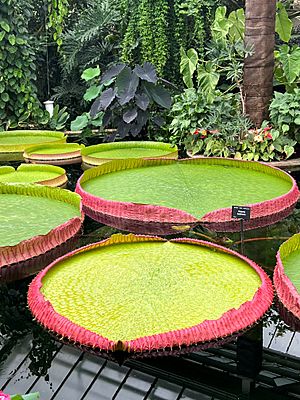Bolivian waterlily facts for kids
Quick facts for kids Victoria boliviana |
|
|---|---|
 |
|
| Victoria boliviana growing at Kew Gardens, London | |
| Scientific classification | |
| Genus: |
Victoria (plant)
|
| Species: |
boliviana
|
 |
|
| Distribution of Victoria boliviana | |
Victoria boliviana, also called the Bolivian waterlily, is a giant new type of water lily. It belongs to the Victoria group of plants. This amazing plant was officially identified in 2022. It is the newest and largest known water lily species in the world!
In January 2023, Victoria boliviana earned three Guinness World Records. It was recognized as the world's largest water lily species. It also holds records for the world's largest water lily leaf and the world's largest undivided leaf. These records were given to a specific plant grown in 2012 at La Rinconada Gardens in Santa Cruz, Bolivia.
Contents
What's in a Name?
The second part of its name, boliviana, tells us where this giant water lily comes from. It was found in Bolivia.
Meet the Giant Waterlily
Huge Leaves
The leaves of Victoria boliviana are truly enormous. They often grow to be about 3 meters (almost 10 feet) wide! The biggest leaf ever recorded was 3.2 meters (about 10.5 feet) across. This record-breaking leaf grew in the La Rinconada Gardens in Bolivia.
These leaves are so strong and big that they can even hold the weight of an adult human! Alberto Trinco, who manages the conservatory at the Royal Botanic Gardens, Kew, showed this amazing fact.
Beautiful Flowers
Each year, the lily produces many flowers. They open one at a time and only bloom for two nights. When they first open, the flowers are white. Then, they slowly change color and turn pink. The flowers are also covered in small prickles.
How Scientists Identified It
Scientists found it tricky to study these giant water lilies. This is because they are so big and delicate. It's also hard to collect samples without damaging them.
How it Differs from Other Giant Lilies
Victoria boliviana has several unique features that set it apart from its relatives, Victoria amazonica and Victoria cruziana. For example, its seeds and ovules (which become seeds) are much larger. They are about 70% longer and wider than those of the other two species.
Its leaves also have a rim that is a medium height. Unlike V. amazonica and V. cruziana, this new species does not have tiny hairs (called trichomes) on its outer flower parts or on its ovary.
Where it Lives
This amazing water lily naturally grows in the wetlands of Bolivia. Scientists have observed that beetles help to pollinate its flowers. This means beetles carry pollen from one flower to another, helping the plant make seeds.
A Bit of History
For a long time, people didn't realize that this water lily was a unique species. There were even drawings of it from 1845 in collections at Kew Gardens!
In 2016, seeds from Bolivia were given to the Royal Botanic Gardens Kew in London. Scientists there studied the plant's genes. Their research finally showed that this third Victoria species was indeed different and special. This led to its official identification in 2022.
Protecting This Plant
Scientists believe that Victoria boliviana might be vulnerable or endangered. This means it could be at risk of disappearing if we don't protect it. There are only five known groups of these plants living in Bolivia.
Gallery
See also
 In Spanish: Victoria boliviana para niños
In Spanish: Victoria boliviana para niños




